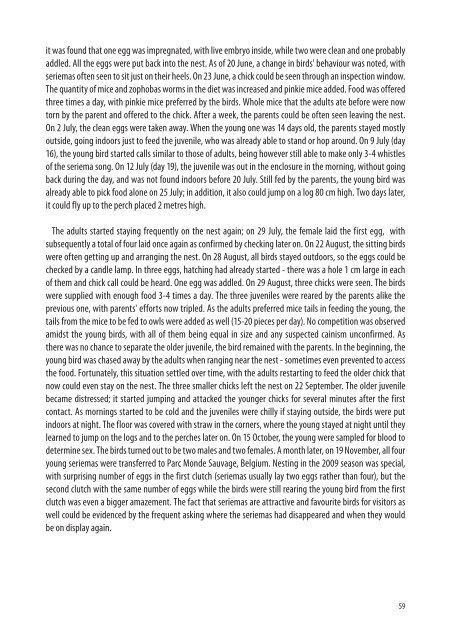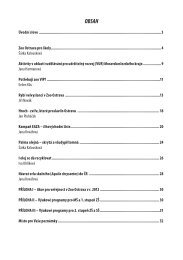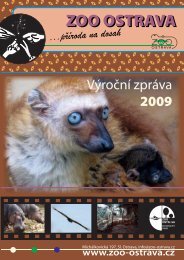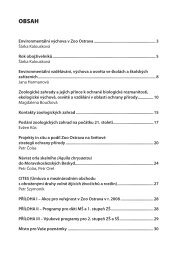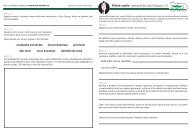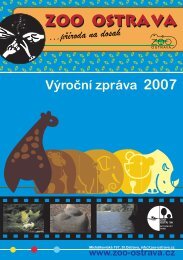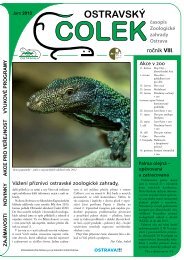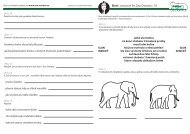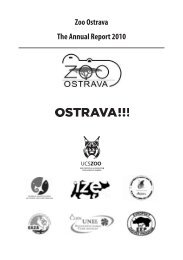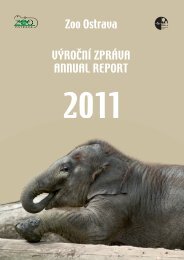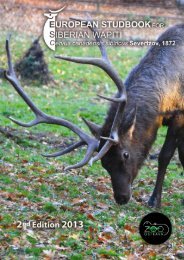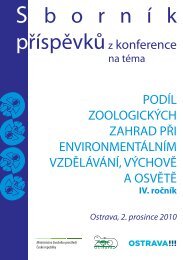You also want an ePaper? Increase the reach of your titles
YUMPU automatically turns print PDFs into web optimized ePapers that Google loves.
it was found that one egg was impregnated, with live embryo inside, while two were clean and one probably<br />
addled. All the eggs were put back into the nest. As of 20 June, a change in birds' behaviour was noted, with<br />
seriemas often seen to sit just on their heels. On 23 June, a chick could be seen through an inspection window.<br />
<strong>The</strong> quantity of mice and zophobas worms in the diet was increased and pinkie mice added. Food was offered<br />
three times a day, with pinkie mice preferred by the birds. Whole mice that the adults ate before were now<br />
torn by the parent and offered to the chick. After a week, the parents could be often seen leaving the nest.<br />
On 2 July, the clean eggs were taken away. When the young one was 14 days old, the parents stayed mostly<br />
outside, going indoors just to feed the juvenile, who was already able to stand or hop around. On 9 July (day<br />
16), the young bird started calls similar to those of adults, being however still able to make only 3-4 whistles<br />
of the seriema song. On 12 July (day 19), the juvenile was out in the enclosure in the morning, without going<br />
back during the day, and was not found indoors before 20 July. Still fed by the parents, the young bird was<br />
already able to pick food alone on 25 July; in addition, it also could jump on a log 80 cm high. Two days later,<br />
it could fly up to the perch placed 2 metres high.<br />
<strong>The</strong> adults started staying frequently on the nest again; on 29 July, the female laid the first egg, with<br />
subsequently a total of four laid once again as confirmed by checking later on. On 22 August, the sitting birds<br />
were often getting up and arranging the nest. On 28 August, all birds stayed outdoors, so the eggs could be<br />
checked by a candle lamp. In three eggs, hatching had already started - there was a hole 1 cm large in each<br />
of them and chick call could be heard. One egg was addled. On 29 August, three chicks were seen. <strong>The</strong> birds<br />
were supplied with enough food 3-4 times a day. <strong>The</strong> three juveniles were reared by the parents alike the<br />
previous one, with parents' efforts now tripled. As the adults preferred mice tails in feeding the young, the<br />
tails from the mice to be fed to owls were added as well (15-20 pieces per day). No competition was observed<br />
amidst the young birds, with all of them being equal in size and any suspected cainism unconfirmed. As<br />
there was no chance to separate the older juvenile, the bird remained with the parents. In the beginning, the<br />
young bird was chased away by the adults when ranging near the nest - sometimes even prevented to access<br />
the food. Fortunately, this situation settled over time, with the adults restarting to feed the older chick that<br />
now could even stay on the nest. <strong>The</strong> three smaller chicks left the nest on 22 September. <strong>The</strong> older juvenile<br />
became distressed; it started jumping and attacked the younger chicks for several minutes after the first<br />
contact. As mornings started to be cold and the juveniles were chilly if staying outside, the birds were put<br />
indoors at night. <strong>The</strong> floor was covered with straw in the corners, where the young stayed at night until they<br />
learned to jump on the logs and to the perches later on. On 15 October, the young were sampled for blood to<br />
determine sex. <strong>The</strong> birds turned out to be two males and two females. A month later, on 19 November, all four<br />
young seriemas were transferred to Parc Monde Sauvage, Belgium. Nesting in the <strong>2009</strong> season was special,<br />
with surprising number of eggs in the first clutch (seriemas usually lay two eggs rather than four), but the<br />
second clutch with the same number of eggs while the birds were still rearing the young bird from the first<br />
clutch was even a bigger amazement. <strong>The</strong> fact that seriemas are attractive and favourite birds for visitors as<br />
well could be evidenced by the frequent asking where the seriemas had disappeared and when they would<br />
be on display again.<br />
59


